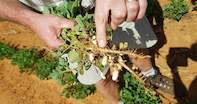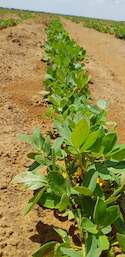The terms groundnuts and peanuts can be used interchangeably, but in South Africa the industry primarily refers to groundnuts, whereas peanuts are used in North and South America.

Groundnuts (peanuts) form part of the oilseed family, and as indicated by its name, produce pods or nuts, underneath the ground.
The cultivated species originated around southern Bolivia and north-western Argentina along the eastern slopes of the Andes mountains, with evidence of it being used for human consumption since the Inca times. From here it spread with nomads to other parts of North America and was later taken to other parts of the world by Portuguese seafarers.
Groundnuts (peanuts), today, are produced across the world, primarily in sandy soils in tropical and warm temperate regions.
Global Production of Peanuts
The area under groundnut (peanut) production has remained relatively stable over the past forty-five years, increasing from just below 20 million in the early 1970s to just over 25 million hectares in 2018, according to the Bureau for Food and Agricultural Policy (BFAP).
Peanut production over this time, has increased substantially thanks to the development of new cultivars, resulting in average yields increasing from about 1,1 tons per hectare to 1,8 tons per hectare and the international average production volume increasing from just over 15 million tons to between 40 million and 45 million tons per year.
China is the leading producer, accounting for over 15 million tons of the world’s production each year, followed by India, whose production fluctuates between 4 million and 7 million tons per year.
For the past 45 years, the United States has been the overall leader in terms of yields per hectare, with yields increasing from 2,5 tons per hectare to 4,5 tons per hectare over the past twenty years thanks to their use of the Runner cultivar.
India and the United States are the biggest exporters, with China, Argentina and the Netherlands also exporting large volumes.
Peanut Production History in South Africa
Groundnuts (peanuts) came into South Africa with Portuguese seafarers, along with maize and cassava. Production was first recorded in KwaZulu-Natal in 1843, according to an Afrikaans publication of the old Oilseed Regulatory Board, called (Historiese Oorsig van die Oliesadebedryf in Suid-Afrika).
Production took off soon thereafter, in Transvaal, with the first trading records being made in 1905 in Northern Transvaal.
Local Production of Peanuts
South African production of peanuts has fluctuated greatly over the past twenty years, but generally declined with the introduction of new cultivars not making up for the loss in production area. Intermittent droughts in major production areas over the five years leading up to 2020, further exacerbated the situation.
Adri Botha, chairperson of the SA Groundnut Forum, says a lot is being done to promote production again, as groundnuts (peanuts) give good returns and make for an excellent rotational crop, especially in maize rotations, thanks to its ability to fix nitrogen.
The development of new technology has also significantly reduced production associated risks, by allowing farmers to supply the nuts in bulk at an earlier stage, whereas the nuts had to be left on the land for up to two weeks to dry and then had to be delivered in bags in the past.
The development of improved mechanical harvesters is also significantly driving down labour costs. Besides this, various attempts are made to stimulate the local industry and protect it from cheap imports.
Peanut Production Area
Groundnuts (or Peanuts) are grown in the summer rainfall areas of South Africa, primarily in the Northern Cape, Free State, Limpopo and North West.
Most of the plantings in the Free State and North West are on dryland, while those in the Northern Cape and Limpopo are under irrigation. Production in the Free State has declined significantly due to farmers rather planting soybean, because it is less labour intensive and presents lower climate associated risks.
Peanut Varieties

Groundnuts (peanuts) are grown from the Spanish type of varieties in South Africa. Cultivar evaluation and production trials already started in various provinces after the Anglo Boer war that ended in 1902, leading to Virginia Bunch (Valencia) becoming the most planted variety at the time. The variety, however, did not thrive under South African climatic conditions.
JFP Schellschop from the Agricultural Research Centre (ARC) is seen as one of the pioneers in the industry. In 1942, he developed an improved cultivar, called the Natal Common, out of the Spanish variety grown in Natal. The variety, over time, gained renowned success across the world.
Other varieties that developed out of Schellschop’s programme included Seleksie 5, Ghimbaura, Nelspan and G280. The ARC developed various other valuable varieties thereafter, with ARC Akwa Plus and ARC Sallie Plus being the best performers at the moment.
In 2019, they had six cultivars in the pipeline that promised to boost yields and improve disease resistance. The private sector has also been evaluating some imported varieties, but this is getting harder since countries see this intellectual property as an advantage over their competitors.
Farmers usually plant a variety of peanut cultivars to reduce disease, pest and climatic risks.
Harvesting of Peanuts
The number of days to maturity varies between cultivars and according to climatic conditions. On average, however, it takes about ninety days for the peanut (groundnut) pods to mature.
Pods are generally picked when the walls display a dark-brown colour and when the seed is white, changing to pink. The groundnuts (peanuts) are lifted by a digger shaker windrower out of the ground.
Global and Local Sales of Peanuts
South Africa has to import groundnuts (peanuts) to make up for local production shortfalls. Imports fluctuate depending on local production volumes, reaching a peak of 55 000 tons in 2016 and over 30 000 tons in 2017.
Roughly 80% of the groundnuts (peanuts) in South Africa is used for consumption, whereas the rest is crushed. In the rest of the world, the trend is for about 40% to be crushed and the rest to be used in the food market.
The direct edible market has been declining slightly in South Africa over the past ten years, whereas the groundnut / peanut butter market has increased, now accounting for about 30 000 tons each per year. Feed waste consumption has stayed relatively constant until 2007, after which it increased from 2,5 million tons to 5 million tons in 2018.
Uses of Peanuts
The seeds yield edible oil that can be used in cooking, margarines, salads, canning for deep-frying and for shortening in pastry and bread. The seeds may be eaten raw, whole roasted and salted or chopped in confectioneries or ground into peanut butter. Young pods and leaves can also be consumed as a vegetable.
Groundnuts (peanuts), according to the Agricultural Research Centre, also have various industrial uses, ranging from pharmaceutical applications to the development of soaps, lotions and creams. The hulls can also be used as filler for fertiliser and as fuel.
Besides this, oilcake can be used as a high protein animal feed, whereas the vines, leaves, hulls and shells also can be used as livestock feed.